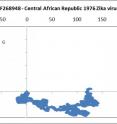Application of novel alignment-free sequence descriptors in Zika virus characterization
The recent epidemic of Zika virus infections in South and Latin America has raised serious concerns on its ramifications for the population in the Americas and spread of the virus worldwide. The Zika virus disease is a relatively new phenomenon for which sufficient and comprehensive data and investigative reports have not been available to date. Although first recognized as a new virus in 1947 in Uganda's Zika forest animals, its debilitating effect on human fetuses leading to babies being born with smaller braincases (microcephaly) was not known or well investigated until its epidemic form in Yap Island, Micronesia, in 2013 and now in the South American countries in 2015-16. The concern is so high that public health authorities in some countries such as Colombia, Ecuador, El Salvador, and Jamaica have asked their women to avoid pregnancies until the virus is better understood. The World Health Organization (WHO) has labeled the outbreak of such abnormalities as a Public Health Emergency of International Concern. The Zika virus is spread by the Aedes aegypti mosquito which is prevalent in tropical climate regions, but is spreading northwards following global warming trends. To understand the nature of the virus we undertook a special bioinformatics study of its complete RNA sequence from African and non-African, i.e., Asian, Pacific and American, sources. We know that viral sequences mutate much more rapidly than, say, mammalian sequences. We found that the African Zika viral sequences were distinctly separate compared to the non-African sequences.
This difference is evident dramatically from two graphs of the Zika genome, one from Central African Republic and another from Brazil. The graphs are representations of the Zika RNA sequences through our model where the nucleotides of a sequence are plotted sequentially on a 2-dimensional grid by a set algorithm. Such a representation allows us to project a visual rendering of the distribution of nucleotides in a sequence and also to quantitatively index a sequence through numerical sequence descriptors and measure similarities and dissimilarities among sequences. While the normal practice is to use various alignment techniques like BLAST, CLUSTALW, etc. to measure such differences, our approach allows for a novel method of genome characterization called alignment-free measures and is therefore independent of several assumptions. Results such as ours provide more focus to surveillance of the spread and mutations of the Zika virus and hopefully can contribute to the eventual development of suitable drugs and vaccines that target the expression of specific Zika virus genes or the products expressed by these genes.
Source: Bentham Science Publishers
Articles on the same topic
- Zika virus may now be tied to another brain diseaseSun, 10 Apr 2016, 20:31:55 UTC
- New survey on American attitudes toward Zika virus finds limited awareness or concernThu, 7 Apr 2016, 19:12:18 UTC
- Trophoblasts resistant to Zika/Zika in the mouseThu, 7 Apr 2016, 19:10:53 UTC
- New mouse model to aid testing of Zika vaccine, therapeuticsThu, 7 Apr 2016, 19:10:40 UTC
Other sources
- Mapping city hotspots for Zika mosquitofrom Science DailyTue, 12 Apr 2016, 16:01:08 UTC
- Lab-Grown Mini Brains Die When Exposed To Zikafrom PopSciMon, 11 Apr 2016, 19:20:40 UTC
- Zika Virus Linked with Another Brain Disease: What's ADEM?from Live ScienceMon, 11 Apr 2016, 18:11:01 UTC
- Zika-linked brain disorder in adults identified by Brazilian scientistsfrom CBC: HealthMon, 11 Apr 2016, 15:30:39 UTC
- Zika virus may now be tied to another brain diseasefrom Science DailyMon, 11 Apr 2016, 13:20:49 UTC
- Zika may be linked to autoimmune brain disorderfrom UPIMon, 11 Apr 2016, 1:30:42 UTC
- Study: Zika may be linked to autoimmune brain disorderfrom UPIMon, 11 Apr 2016, 1:00:44 UTC
- Application of novel alignment-free sequence descriptors in Zika virus characterizationfrom Science DailySat, 9 Apr 2016, 14:20:52 UTC
- Zika Forest Journal: In a Remote Ugandan Lab, Encounters With the Zika Virus and Mosquitoes Decades Agofrom NY Times HealthSat, 9 Apr 2016, 12:00:45 UTC
- Obama Administration to Transfer Ebola Funds to Zika Fightfrom NY Times HealthSat, 9 Apr 2016, 12:00:41 UTC
- New survey on American attitudes toward Zika virus finds limited awareness or concernfrom Science DailyThu, 7 Apr 2016, 20:00:43 UTC
- Poll: Some key gaps in Americans' knowledge about Zika virusfrom AP HealthThu, 7 Apr 2016, 18:01:24 UTC
- U.S. moving money from Ebola fund to help fight Zikafrom UPIWed, 6 Apr 2016, 19:40:39 UTC
- Trophoblasts resistant to Zika/Zika in the mousefrom Science DailyWed, 6 Apr 2016, 1:00:55 UTC
- New mouse model to aid testing of Zika vaccine, therapeuticsfrom Science DailyWed, 6 Apr 2016, 1:00:52 UTC
- White House to transfer Ebola funds to combat Zika virusfrom AP HealthTue, 5 Apr 2016, 23:10:35 UTC
- Hawaii researchers focus on data to combat Zika virusfrom AP HealthTue, 5 Apr 2016, 9:00:51 UTC

